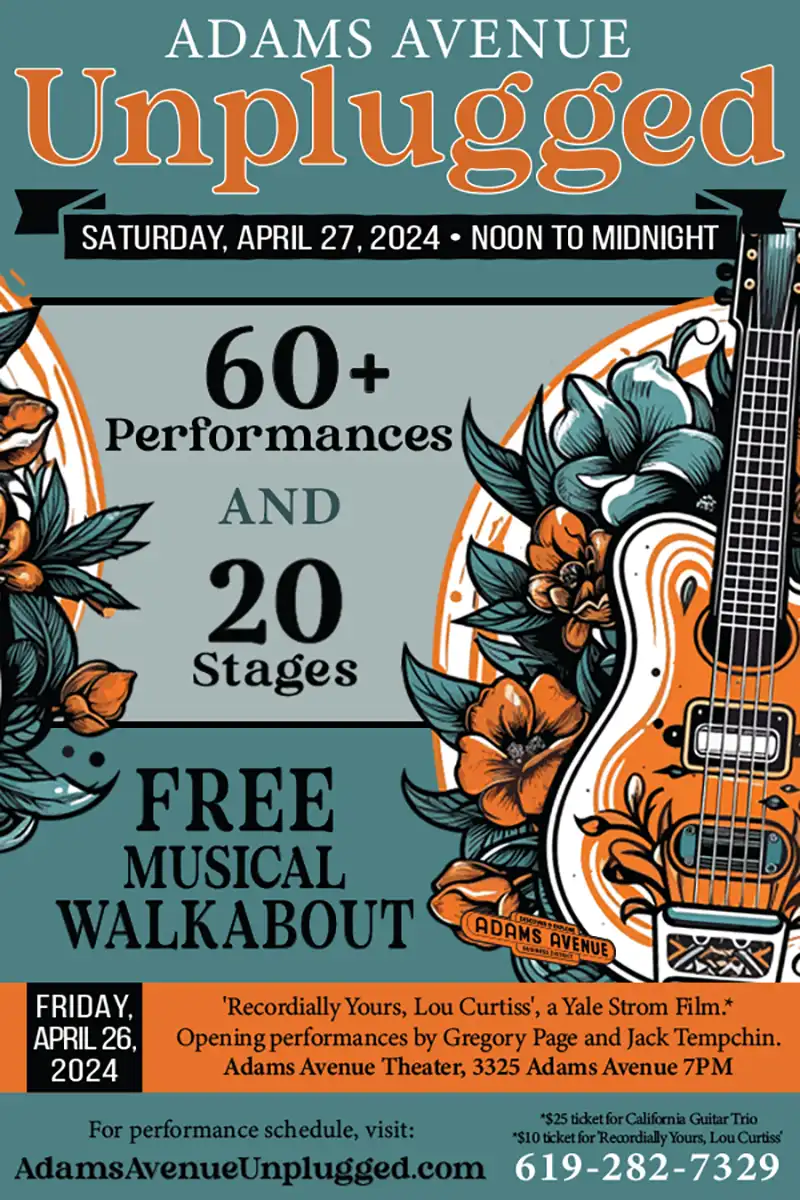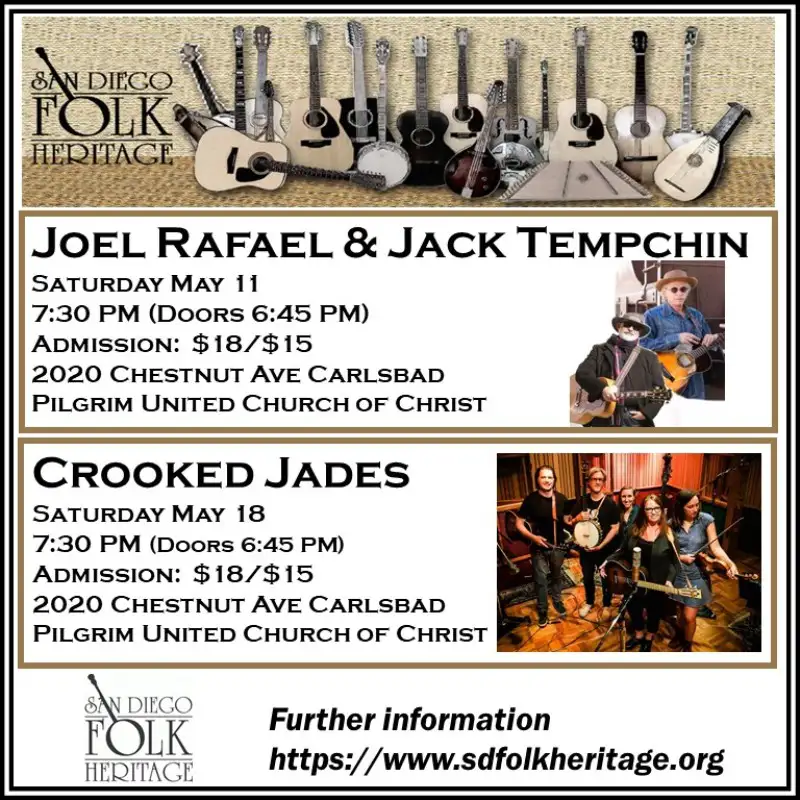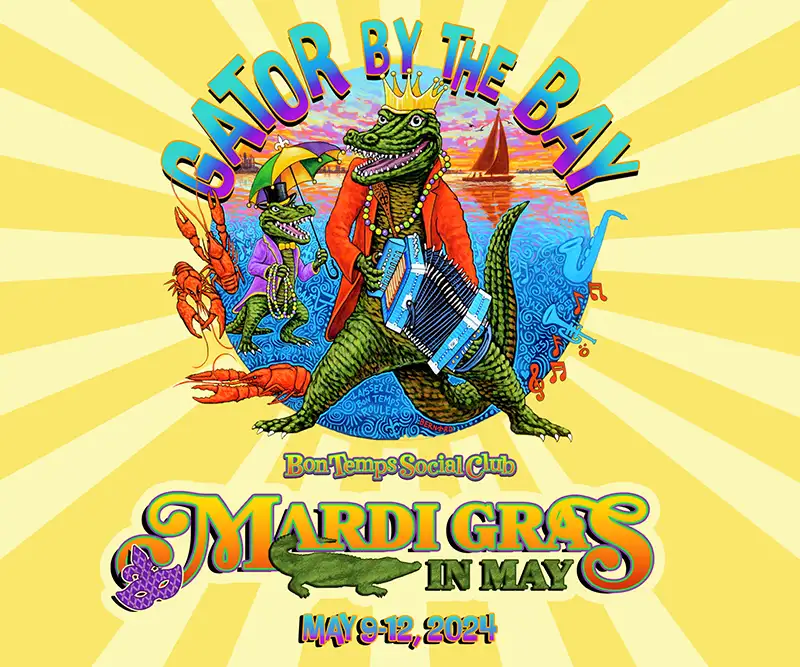Yesterday And Today
Digging Up the Roots of Adams Avenue Unplugged… and creating community as commerce courts art as the cost of doing business
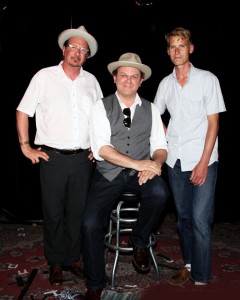
Reilly & Friends (pictured with Gregory Page & Tom Brosseau)
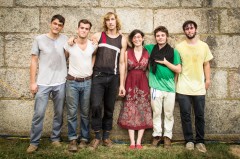
Spirit Family Reunion
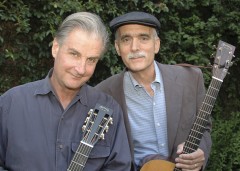
Geoff Muldaur & Jim Kweskin
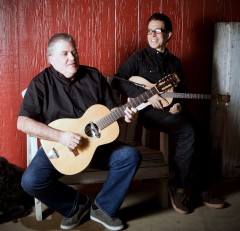
David Hidalgo & Louis Perez of Los Lobos
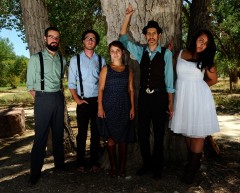
Haunted Windchimes
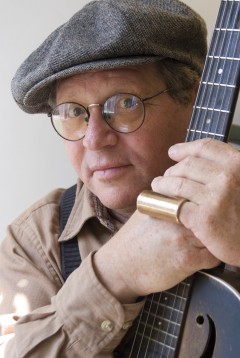
Robin Henkel
Community: a group of people with a common characteristic or interest living together within a larger society.
A week or so ago we all kicked off the clouds of winter, sprung our collective clocks forward, and with the extra daylight hour psychologically aligned ourselves with the onset of spring. Thank the gods as the days get longer and with April now upon us there is the usual flood of concerts and related music festivals about to be descend upon our fair city — from now until the end of autumn. And I dare say that one of the most significant and enduring traditions on the annual San Diego music calendar is the upcoming Adams Avenue Unplugged at the end of this month over the weekend of April 27-28.
Over 100 artists will perform at 26 different locations across a two-mile stretch of Adams Avenue that begins in University Heights and works its way eastward through the neighborhoods of Normal Heights and Kensington. It’s a free musical walkabout and the talent that is booked for this year’s event is remarkable, with scores of San Diego’s top musicians sharing the stage with a number of significant out of town guests, including San Diego’s Los Alacranes who will be joined by special guests Louie Perez and David Hidalgo of Los Lobos. Also headlining are folk legends Jim Kweskin and Geoff Muldaur of the Jim Kweskin Jug Band and Oscar-nominated actor John C. Reilly returns with his friends Tom Brosseau, Willie Watson, and Dan Bern in a performance that is bound to attract another capacity audience similar to Reilly’s performance from last year. Performances by Haunted Windchimes from Colorado (featured on “A Prairie Home Companion”) and the Spirit Family Reunion from New York City are also highly anticipated.
Notable locals scheduled to play include Cindy Lee Berryhill, Tomcat Courtney, Joey Harris, Dave Humphries, Marie Haddad, Jeffrey Joe Morin, Gregory Page, Sara Petite, Joe Rathburn, Lisa Sanders, and many others, including San Diego mainstay and blues guitar master Robin Henkel, who has performed at every spring festival over the last decade, including the very first Roots Festival in 1994.
Although it would be accurate to call this “the second annual Adams Avenue Unplugged,” that would seriously belie the history and the origins of what has been an ongoing tradition in San Diego more or less for the last 46 years, starting with the San Diego Folk Music Festivals at San Diego State University back in 1967. Scott Kessler, executive director of the Adams Avenue Business Association explains how the district got involved in putting on these yearly events: “The Adams Avenue Street Fair started here in 1982. The Street Fair is usually the last weekend in September and the Roots Festivals are put on in April so that we’d have a music event in the spring and one in the fall. We started the Roots Festival in ’94 and last year we really transitioned it. We got rid of the block party format and went to more of the stages inside to the private settings. This year we’re going to put more production into our three outdoor stages so that there’s a better balance. If you don’t want to go to a restaurant or bar we’ll have four stages playing, including the church stage [at the Normal Heights United Methodist Church on Mansfield Street].
“This is for the business district so one of the things that we’re supposed to do is promote the area for the benefit of the merchants. We’ve always excelled at special events here and we have a niche in highlighting the music. We’ve had lots of other events here too over the years: we had a classic car show, we had a book fair, an antique fair. It’s a way to get them to pay attention — they come up here for a special event and hopefully they return after that.”
It sounds like the festivals were invented as a marketing device, with a bit of cultural cache mixed in…
Kessler continues, “Well, here’s the thing — I could talk on both sides of the issue. As the business association we look at it as marketing. But we also look at it as a community building exercise and a cultural organizing exercise. We’re not paid to promote music concerts we’re paid to promote the business district. So the events serve a lot of different purposes. The events from the business associations perspective is that it brings a lot of customers in for the weekend, it’s good for business and it brings those people back, people like Dick and Anna at Mariposa Ice Cream; they were vendors and they settled here [along Adams Avenue] because of the Street Fair.
“I started in 1989 with the eighth Street Fair. The Roots Festival didn’t start until ’94. It was when we started pushing music in the Street Fair and in ’93 I met Lou Curtiss and Lou was like, ‘Why don’t we do more?’ of his type of thing, more roots music and I suggested doing separate events. We used the same model as a block party format to sell vendors, you put up stages but instead of pop music… the Roots Festival was always about looking back and the Street Fair was like looking forward is how we used to say it.”
The Roots Festival was always about paying homage to traditional forms and there certainly isn’t anyone in San Diego that has been more respectful or passionate in preserving the traditions of our musical past as much as Mister Lou Curtiss, the owner of Folk Arts Rare Records and one of the originators of the long defunct San Diego Folk Festival. “We did our first festival back in 1967 at San Diego State University” says Curtiss. “We did it from ’67 to ’87 at SDSU and put on 20 festivals. After a seven-year hiatus we then started doing them on Adams Avenue in 1994. I tried a couple of blues festivals in between there, tried five different times to get a blues festival going. Had some really great people but the blues boom hadn’t hit yet. I did a festival in 1980 that had Clarence ‘Gatemouth’ Brown, Lowell Fulson, Roy Brown, and all of the local blues guys like Tomcat [Courtney]… and we just couldn’t get a crowd for it. A few years later if we’d have done that same festival it would have been packed. I booked some blues artists at my folk festivals: we had Skip James at the second festival in 1968. Two years later we had Robert Pete Williams and Juke Boy Bonner. That’s something I always tried to do: I never went for what I considered ‘big names,’ I went for people who were important for the music and for bringing the music along because if we don’t pass it down from one generation to the next generation it just isn’t going to be here.
“I always try to bring people who are famous, but were maybe famous in the 1930s or even the 1920s. Of course, a lot of the old timers were still alive then and it was easier to hear ’em. It’s harder now to find it, some of those different kinds of music.
“So there was the San Diego Folk Song Society [started by Sam Hinton] and the festival was a natural extension of that. Eventually I became the de facto head and started doing all of the booking. That started in 1967 and it got pretty big at one point. By the eleventh festival we went from Tuesday through Sunday. As I got a little older and grayer it got harder to make the sell to the Cultural Arts Board of the student body. Gradually it started getting smaller and smaller and after the 20th festival they just kind of gave it up.
“Now I started [Folk Arts Rare Records] here at the same time as I started the festival, so that we would more or less have a headquarters. Our first shop was down on the corner of Washington and India where Gelato Vero is now. We were there five years [from ’67 to ’72] then we moved up to Hillcrest [at 3743 Fifth Avenue] and did concerts in the store at the same time, every weekend. People like Tom Waits would perform. From there we went to 3611 Adams Avenue for the next 27 years and then we moved up here (at 2881 Adams Avenue) almost ten years ago.
“In 1994 Scott Kessler came to see me about doing some of the booking on the Adams Avenue Street Fair. I said I’d be glad to do that but I’d really like to get some kind of a folk festival going again. “How about if we do a spring festival and a fall festival?” Okay, let’s try it and see how it works. So for the next 15 years I booked the Adams Avenue Roots Festival.”
Guitarist Robin Henkel (who’ll be performing on the Park Stage this year) thinks “that the general flow has really changed in the last few years because there’s a new format. We’re discovering the new format and making that work the best that we can. The vibe of the old festival… you know it was a folk festival back then and that whole element has really changed now that it’s called Unplugged.
They’re trying to stay with the times. But the vibe, historically, has always been really, really great. People are walking around, they’re feeling good… as far as being a performer the audience has always been really special and accepting and ready to hear some music. Back when I used to perform in the beer garden on Mansfield Street I would be setting up my gear and getting catcalls and hooting and shouting from the audience, they’re rarin’ to go; they want to hear something you know? And that’s all positive, ’cause it makes all the performers feel really special. And that hasn’t been lost, that’s still there.”
When asked if there will be any difference to his approach now that the festival is called “Unplugged” Henkel says, “No, to me it’s the same thing. In the past the performers that played there were traditional folk and blues artists and now there’s a little bit of a wild card by introducing all those different artists and different venues. We’ll have a little sound system and another place doesn’t. So as far as the performers are concerned, they have to go in and see what’s working, because each place is different. Some of the places are really noisy and some of the places have a really attentive and focused audience. Some people can handle playing in front of a loud noisy audience but sometimes a loud crowd ruins it. I think maybe as time goes on the performers that play a softer music where it’s important to hear the lyrics will find certain venues that are more conducive to that and there are other venues where people just want to slam it down and party, like in some of the bars. But I feel lucky that I can slide either way because I do play with an amp and I can crank my amp up and deliver a good strong beat for people. And this year I’ll be performing with Whitney Shay; I don’t know if you’ve seen Whitney before but she is a sparkling, young new talent. A blues and jazz singer. She just delivers it, she’s big fun. We’ll do a repertoire of blues, jazz, swing, and country blues.”
So, how do you manage to put on a weekend long music festival that’s free and manage to compensate everyone in the process?
Scott Kessler says, “We’ve always paid everyone, even if it’s nominal. We bring in money from the vendors and that’s how we pay for the musicians. We spent $35,000 last year on musicians’ fees just for the Street Fair. And for the Roots Festival we used to have a budget between 18 and 20 thousand. So, last year with the Unplugged Festival we cut it down to about 10 and now this year it’s gone up to 14 cause we brought in some national touring acts.
“You know, we’ve always felt that we focus on the local talent; we try to do a really good job of promoting them. We put ’em in the program, we put their names in the ad we do in the Reader and it’s always about the musicians. We can’t afford to pay scale wages but we pay everything that we can. With the Street Fair, we really didn’t start making money until the mid-’90s, so we seeded that event for years to get it up. We have a huge vendor base, which is how we are able to pay the musicians. And we would just reinvest the profits and kind of kept growing it until it was self-sustaining. Now the Street Fair actually pays for the full-time staff in here so that we can do all the other community enhancements that we do.
“Now, the neighborhood has this kind of buzz going — Normal Heights and Adams Avenue, but it’s 30 years of working in the trenches, planting the trees, putting in the new curb gutters and new sidewalks. We’ve remodeled 60 storefronts on the Avenue. We built this school [gestures out the window of the business association] across the street from us. We call it the School Annex. There were rundown properties there that were owned by the church; we leased the land from them and built a school facility that houses 120 kids and now it houses a charter school for the neighborhood. We act as a community development corporation and we make some money from it and again, we just plow everything back into improving the community. A business association building schools is pretty unusual but we saw that in order to strengthen the community we needed more alternative educational choices here. Why do people move to communities? Because they have good schools. You create a sense of community among people so that they feel that they belong to something. All people are looking for that, it’s just innate and I don’t know if there’s a formula to it; you just keep trying things and if it works you do more of that.”
Finally, on the name change Kessler says, “the reason that we called it Unplugged was to basically broaden the horizon, whereas Roots was more traditional stuff. And Unplugged allows us to still to do that but now we can do more.” Curtiss thinks that the name change “is a good idea — my only problem with it is there just isn’t the money to bring in the real traditional music. So frankly, I’m just not as interested in it as I would be. The singer-songwriters have taken over the world, not that I don’t like a lot of the music, because I do. Gregory Page is one of my favorite people. But it’s hard to get anybody to book anything that isn’t contemporary anymore or so-called Americana,” a term that Curtiss doesn’t particularly care for. ‘I think it’s misleading.’ he says. ‘It originally might have been a good idea for people who are writing what sounded like old-time songs, but it’s just come to be a catch all phrase for songwriters, so it doesn’t really mean anything anymore. But it’s just like using the term folk music.’”
And how do you define folk music?
Curtiss: “Big Bill Broonzy said it: ‘You ain’t never heard a mule sing.’ I guess a song becomes a folk song when it’s passed down from one generation to the next and its changed somewhat. It passes into tradition and people forget that there was a writer originally. Although, of course, you can do some digging and maybe find out that there was a writer of the song… folk songs are like the songs that everybody sings. And that goes from anything we generally think of as a folk song, like ‘Happy Birthday to You’ to a Chuck Berry song.”
By that definition isn’t hip hop and rap folk music?
“Yeah, definitely,” says Curtiss, “although it went through names like talking blues… it changes and gets passed down.”
Don’t miss Adams Avenue Unplugged, Saturday, April 27, noon-10pm, and Sunday, April 28, noon-8pm; along Adams Avenue, from 30th Street to Marlborough Street in Kensington. For a full line-up and schedule, go to: http://www.adamsavenuebusiness.com/Adams-Avenue-Unplugged.html


